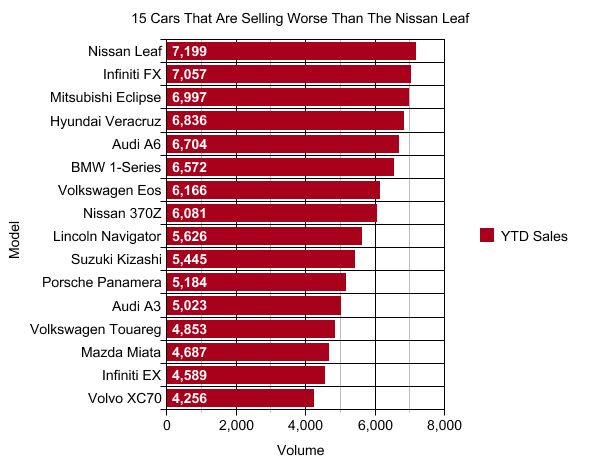The EV Market In Context: 15 Cars That Are Selling Worse Than The Nissan Leaf (And Chevy Volt)
Because electric cars represent the first fundamental technological shift for the automobile since its invention, their appearance on the US market has elicited quite a bit of skepticism. And as with any new technology, the first generation of EVs does have some serious downsides. For example, you can charge a Nissan Leaf at any outlet, but it takes 21 hours. Also, the Leaf’s range that was once promised at 100 miles is typically under 70 miles in the real world. Plus, it’s not exactly cheap. In the face of these challenges, you might think the Leaf, the first mass-market pure-EV in the US, would be forever doomed to a small niche of the market. But small compared to what? To give a real-world taste of how America’s first pure EV is selling in the context of the broader market, here are the year-to-date sales numbers for the Leaf and 15 other vehicles that you might not expect to be selling worse than an electric car. Incidentally, all of these models are also selling better than the market’s other pioneering plug-in, the Chevrolet Volt… which now has its own graph in the gallery below.
More by Edward Niedermeyer
Latest Car Reviews
Read moreLatest Product Reviews
Read moreRecent Comments
- Analoggrotto With Kia Hyundai you are guaranteed to have the best Maintenance and Service experience in the industry. Complementary diagnostics, open book fees schedules and adherence to published rates with no attempts to tack extra work on are part of the HMC Gold Standard of Service. Recalls are the lowest in the industry but when you bring your Hyundai Genesis Kia vehicle in for Feature Improvement, rest assured that it will be taken care of to the highest pentagon standards, fully free of charge with no pressure for paid work or service unless requested. Hyundai Kia have the highest levels of customer ATP loyalty in the industry and Service is key to the best after sales experience.
- MaintenanceCosts In Toyota's hands, these hybrid powertrains with a single motor and a conventional automatic transmission have not been achieving the same kind of fuel economy benefits as the planetary-gear setups in the smaller cars. It's too bad. Many years ago GM did a group of full-size pickups and SUVs with a 6.0L V8 and a two-motor planetary gear system, and those got the fuel economy boost you'd expect while maintaining big-time towing capacity. Toyota should have done the same with its turbo four and six in the new trucks.
- JMII My C7 isn't too bad maintain wise but it requires 10 quarts of expensive 0W-40 once a year (per GM) and tires are pricey due size and grip requirements. I average about $600 a year in maintenance but a majority of that is due to track usage. Brake fluid, brake pads and tires add up quickly. Wiper blades, coolant flush, transmission fluid, rear diff fluid and a new battery were the other costs. I bought the car in 2018 with 18k in mileage and now it has 42k. Many of the items mentioned are needed between 20k and 40k per GM's service schedule so my ownership period just happens to align with various intervals.I really need to go thru my service spreadsheet and put track related items on a separate tab to get a better picture of what "normal" cost would be. Its likely 75% of my spend is track related.Repairs to date are only $350. I needed a new XM antenna (aftermarket), a cargo net clip, a backup lamp switch and new LED side markers (aftermarket). The LEDs were the most expensive at $220.
- Slavuta I drove it but previous style. Its big, with numb steering feel, and transmission that takes away from whatever the engine has.
- Wjtinfwb Rivaled only by the Prowler and Thunderbird as retro vehicles that missed the mark... by a mile.




































Comments
Join the conversation
I think all of those 7200 Leafs (Leaves?) must have been sold in the Seattle area because I see one pretty much daily. It still has a ways to go to match the Prius (which is pretty much Seattle's official car) but they aren't just a curiosity. Never understood why GM didn't offer the Volt here first and instead let Nissan establish a beachhead. It will be interesting to see if the Volt can dent the Leaf's dominance of the electric vehicle market when it goes on sale here.
It's silly to compare Leaf sales to those of any non-electric. Leaf buyers are eligible for $7500 US government incentives. Leaf buyers in CA get additional incentives. Then, on the other hand, is the low production rate, frustrating those who want to buy them. Some people don't buy Leaves because they can't buy them. Other people don't buy them because they still cost too much even after incentives. Those who buy Leaves now probably paid $1000 for a BluRay player when they first dropped. Still others don't buy Leaves because they don't go far enough on a charge. Still others are skeptical of the Leaf's ability to start, run for any distance , provide adequate cabin heat and defrosting capability in cold weather. Things will probably get better on these fronts.